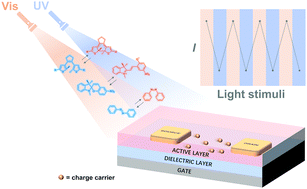Multifunctional organic field effect transistors constructed with photochromic molecules
Abstract
Multifunctional organic field effect transistors (OFETs) that integrate different functions in one device have attracted significant interest due to their significance for practical applications of OFETs. The past decade has witnessed the fast development of OFETs constructed with photochromic molecules as photo-responsive electronics. Photochromic molecules can undergo interconversion or isomerization between two stable/meta-stable states under alternate irradiation. The unique photo-switching performance endows photochromic molecules with an important role in a series of photo-responsive OFETs. The output signals of a photochromic OFET can be reversibly tuned by light triggers via introducing photochromic units into the electronic material system, resulting in a remote-controllable device with potential applications. This review summarizes the recent development of photochromic OFETs in the past decade based on different photochromic categories, e.g. diarylethenes, spiropyrans, and azobenzenes. A brief perspective of photochromic OFETs and their future challenges are also presented.

- This article is part of the themed collections: 2021 Materials Chemistry Frontiers Review-type Articles and The 1st Sauvage Symposium


 Please wait while we load your content...
Please wait while we load your content...